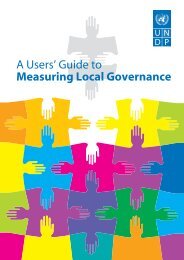English - UNDP
English - UNDP
English - UNDP
Create successful ePaper yourself
Turn your PDF publications into a flip-book with our unique Google optimized e-Paper software.
Tajikistan Project Assessment<br />
a Although information on the effectiveness of training<br />
inputs is missing, district level actors and interviewed<br />
stakeholders from the district development committees<br />
confirmed that training provided in the process of elaborating<br />
district development plans made them better able<br />
to contribute to the planning process. Inclusion of district<br />
council members in the training proved beneficial<br />
for their understanding of the potential role of mid-term<br />
planning in the local development process.<br />
a The project helped improve the government’s information<br />
systems for planning, monitoring, and evaluation of<br />
public policy. This was done by introducing district and<br />
regional authorities to new information collection and<br />
registration tools, and aligning collected data with national<br />
indicators of MDG, National Development Strategy<br />
and Poverty Reduction Strategy targets. In addition to the<br />
main statistical data entry tool, other instruments were<br />
also introduced, such as socio-economic baseline survey<br />
and citizen report cards (these instruments were originally<br />
development within the framework of the DGTTFsupported<br />
project Clean Start for Local Councils – Building<br />
Accountability at the Local Level).<br />
Efficiency<br />
In recognition of the special development situation of<br />
Tajikistan and the limited capacity of local authorities to<br />
execute the project, it was agreed to use the Direct Execution<br />
implementation modality. The project was implemented directly<br />
by <strong>UNDP</strong> Tajikistan under the umbrella of <strong>UNDP</strong>’s Communities<br />
Programme in close collaboration with the government. This<br />
arrangement ensured efficient project delivery, with the overall<br />
responsibility for the management of the project resting with<br />
the Communities Programme.<br />
The Communities Programme adapted its structures as required,<br />
and established transparent project administration procedures<br />
and operation systems. This helped ensure the scheduled<br />
delivery of inputs and production of outputs. The project’s<br />
financial management was based on <strong>UNDP</strong> procedures, and<br />
regular financial reports were prepared.<br />
Innovation<br />
In post-conflict Tajikistan, the gap between districts deepened<br />
as a consequence of the existing differences in the economy,<br />
infrastructure, employment, income, and living standards<br />
between the country’s regions. At the same time, there was a<br />
lack of a comprehensive methodological framework to address<br />
priorities at the national, regional and local level and establish<br />
links between planning and budgeting processes. The project<br />
introduced a unique and innovative approach to prepare district<br />
development plans. It used a participatory approach to identify<br />
strategic priorities and to establish specific local mechanisms,<br />
instruments and indicators, aligned with National Development<br />
Strategy and Poverty Reduction Strategy indicators, and to<br />
allocate the required financial resources to implement priorities.<br />
In addition, the project provided tailor-made capacity<br />
development programme (training and mentoring) on poverty<br />
reduction planning and monitoring, plus design of district<br />
development plans.<br />
Finally, the project supported a new approach to donor aid<br />
coordination through a comprehensive information system.<br />
This system encompassed data from the jamoats, and from<br />
the district and national level on a wide range of issues and in<br />
particular, as a matter of priority, on development and poverty<br />
reduction trends in different parts of the country.<br />
Catalytic effect<br />
The project operated within an existing partnership between<br />
<strong>UNDP</strong> and key national and international development partners,<br />
because it was implemented as a part of the Communities<br />
Programme.<br />
The positive experience and achievements of the project set<br />
the ground for the next phase of the Communities Programme.<br />
The project had secured additional funding from DGTTF (for the<br />
Building a Framework for Local Planning and Budgeting project,<br />
which was integrated into the Communities Programme), as<br />
well as from the UK Department for International Development<br />
and the Canadian International Development Agency.<br />
In addition, the project contributed directly to enhancing<br />
partnerships between <strong>UNDP</strong> and national partners. This is<br />
reflected by the agreements signed between <strong>UNDP</strong> and the<br />
Ministry of Economic Development and Trade, the Strategic<br />
Research Centre, the Institute for the Civil Servants Training, the<br />
Ministry of Finance, the State Statistic Committee, the Ministry<br />
of Labour and Social Protection, and the Parliament.<br />
Sustainability<br />
Based on the results of the DGTTF project and following the<br />
same approach, the District Development Plans were prepared<br />
for the new six districts (in addition to those targeted by the<br />
project). At the same time, three districts that had already<br />
adopted development plans focussed on their implementation.<br />
These activities were implemented within the framework of the<br />
Communities Programme.<br />
The key role in this preparation process and implementation was<br />
and remained with the district development councils. They fulfill<br />
19








![GuÃa del Usuario ] - Governance Assessment Portal](https://img.yumpu.com/44740603/1/190x253/gua-a-del-usuario-governance-assessment-portal.jpg?quality=85)








